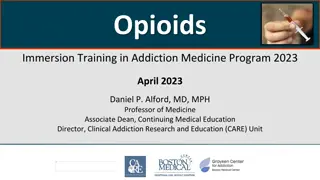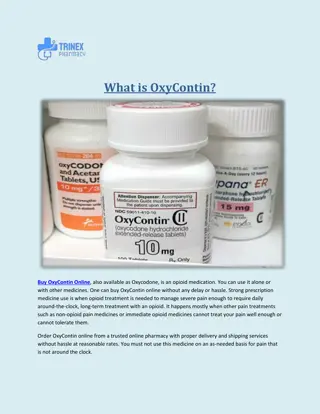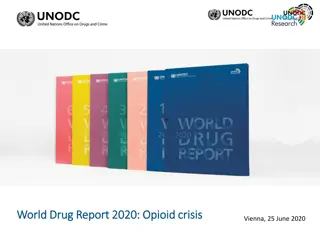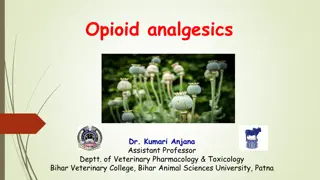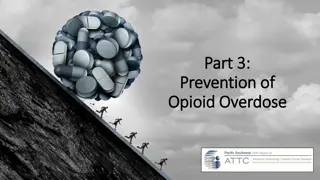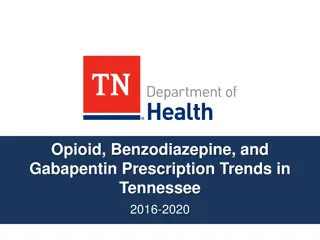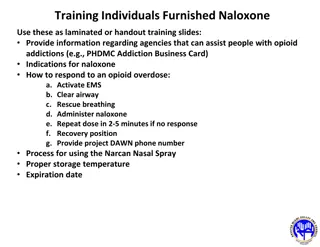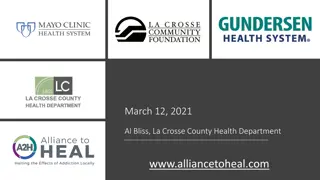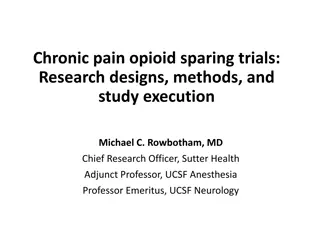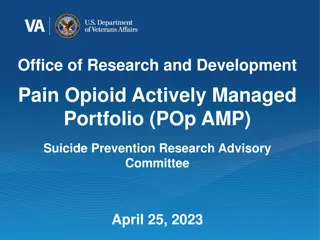Exploring Opioid Use and Disabilities in the United States
This presentation delves into the intersection of opioid use disorders (OUD) among individuals with disabilities, aiming to facilitate their access to appropriate treatment and recovery paths. Despite prevalent opioid-related morbidity, the impact on People with Disabilities (PWD) remains largely unexplored. Recent research indicates a higher likelihood of prescription opioid use, misuse, and use disorder among PWD. Through a comprehensive analysis of national surveys, this project sheds light on the complexities and challenges faced by PWD in managing opioid behaviors and accessing necessary support.
Download Presentation

Please find below an Image/Link to download the presentation.
The content on the website is provided AS IS for your information and personal use only. It may not be sold, licensed, or shared on other websites without obtaining consent from the author. Download presentation by click this link. If you encounter any issues during the download, it is possible that the publisher has removed the file from their server.
E N D
Presentation Transcript
Eric A. Lauer University of New Hampshire February 11, 2020 Eric A. Lauer
The presentation is part of a project of the StatsRRTC, which is funded by the U.S. Department of Health and Human Services, National Institute for Disability, Independent Living, and Rehabilitation Research (NIDILRR) under cooperative agreement H133B130015. This presentation does not necessarily represent the policy of the Department of Health and Human Services, and you should not assume endorsement by the Federal Government (Edgar, 75.620 (b)). The objectives of the INROADS (intersecting research on opioidmisuse, addiction, and disability services) Project, are to explore opioid use disorders (OUD) among people with disabilities, to help them access the treatment they need, pursue recovery, and achieve their goals for functioning well in significant life domains. inroads@brandeis.edu | http://heller.brandeis.edu/ibh/research/inroads/
Approximately 10-20% of people in the United States experience a disability Despite the overwhelming morbidity and mortality associated with the opioid crisis, little is known about the impact of opioid use on PWD Recently, NIDILRR recognized the need for research and characterization of Opioid Use for PWD Opioid DRRP Recent research has found that PWD are more likely to experience prescription opioid use, misuse and use disorder (Lauer, Henly, and Brucker, 2019)
2015-2017 National Survey on Drug Use and Health U.S. DHHS Substance Abuse and Mental Health Services Administration (SAMHSA) In-person household interviews of the U.S. noninstitutionalized, civilian population (12+) Substance use and mental health Bivariate and multivariate modeling methods to estimate percentage, relative risk, and odds of opioid behaviors among PWD and PWOD. Sociodemographic and physical, mental, and behavioral health factors Causes of misuse and treatment All analyses took complex survey design effects into account
Hearing Deaf or serious difficulty hearing? Vision Blind or serious difficulty seeing, even when wearing glasses? Cognition Difficulty remembering, concentrating, or making decisions? Ambulation Serious difficulty walking or climbing stairs? Self-care Difficulty bathing or dressing? Independent living Difficulty going outside the home?
1. Use without misuse Using a drug, excluding misuse, abuse, or dependence, in the past year 2. Misuse without use disorder Using a drug in any way not directed by a doctor, excluding abuse or dependence, in the past year 3. Use disorder (past-year dependence or abuse) Definitions for use disorder was based on American Psychiatric Association Diagnostic and Statistical Manual of Mental Disorders, 4th edition (DSM-IV) criteria * Includes people who also may have used heroin, but does not include people who ONLY used heroin / have a use disorder
Reason for last misuse Pain, relax, deal with feelings/emotions Source for last misuse Doctor, friend, bought (friend/dealer), stole Treatment* Received treatment for illicit drug use and/or alcohol use or abuse * Only asked of those who reported misuse
Demographics: age, gender, race/ethnicity Socioeconomic measures: education, marital status, employment, poverty, metropolitan status Health status and health care: health insurance, self-reported health, Serious mental illness, emergency room visit Substance Use: alcohol use disorder, heroin use / use disorder
50 45.8 45 40 35 28.4 30 25 20 15 10 4.2 3.3 5 1.4 0.5 0 Opioid Use without Misuse Misuse without Disorder OUD Persons with Disabilities Persons without Disabilities
100 89 88.2 90 80 70 60 50 40 30 20 10.3 8.2 10 2.8 1.5 0 Opioid Use without Misuse Misuse without Disorder OUD Persons with Disabilities Persons without Disabilities
56.7 60 50 45.4 40.8 40 33.9 30 17 20 12.1 10 0 Last Misuse Reason: Pain Last Misuse Source: Doctor Treatment for Illicit Drug Use Persons with Disabilities Persons without Disabilities
% Change in Likelihood of OUD 11.3 12 10.8 10 8 6 4 3 2 0 Receipt of Drug or Alcohol Treatment Last Misuse for Pain Serious Mental Illness
PWD vs. PWOD Serious Mental Illness 13.1% vs. 2.1%* Illicit Drug Use (other than pain relievers) 18.1% vs. 16.3%* Alcohol Use Disorder 7.0% vs. 5.7%* Heroin Use or Use Disorder 0.65% vs. 0.29%* Treatment for Illicit Drugs (but not alcohol) 0.76% vs. 0.32%*
PWD vs. PWOD Serious Mental Illness 13.1% vs. 2.1%* Illicit Drug Use (other than pain relievers) 18.1% vs. 16.3%* Alcohol Use Disorder 7.0% vs. 5.7%* Heroin Use or Use Disorder 0.65% vs. 0.29%* Treatment for Illicit Drugs (but not alcohol) 0.76% vs. 0.32%* OUD 7.4% vs. 7.8% 9.4% vs. 5.0%* 11.7% vs. 5.1%* 40.5% vs. 35.0% 12.1% vs. 17%
Overall, people with disabilities more likely to: engage in any prescription opioid use report opioid misuse for pain receive opioid medications from a doctor However, multivariate modeling among opioid users suggests disability is not associated with OUD Predictors of OUD associated with managing pain, receipt of SUD treatment, and serious mental illness
People with disabilities and OUD are also more likely to report other illicit substance use, alcohol use disorder Suggests we may be identifying an extremely vulnerable, at risk population with disabilities not receiving the medical and social supports Additional research is needed to explore pain management and comorbidities Study receipt of treatment for opioid use disorder and across specific types of substance use
Eric A. Lauer Eric.lauer@unh.edu Debra Brucker Debra.Brucker@unh.edu Rachel Adams radams@brandeis.edu Sharon Reif reif@brandeis.edu Monika Mitra mmitra@brandeis.edu Eric A. Lauer Institute on Disability University of New Hampshire Durham, NH 03824 (US) 603-862-4829


